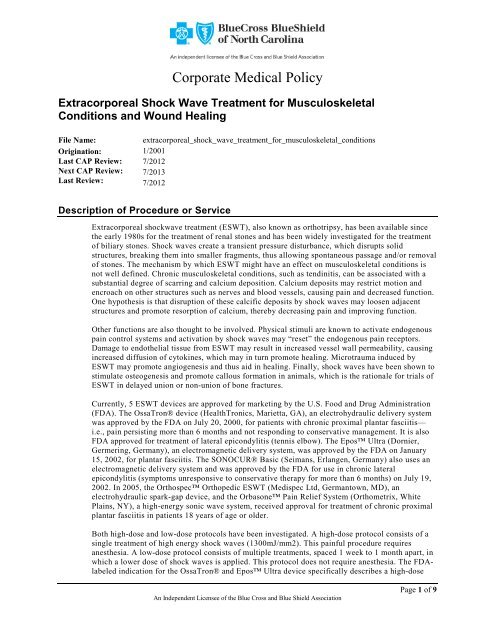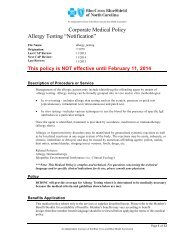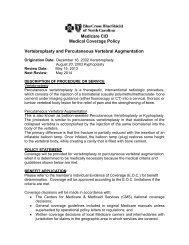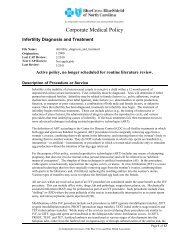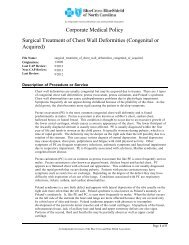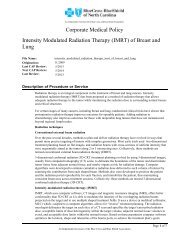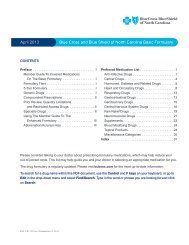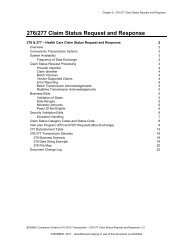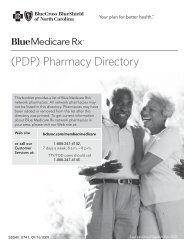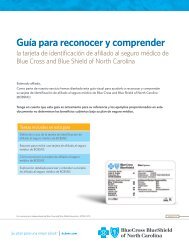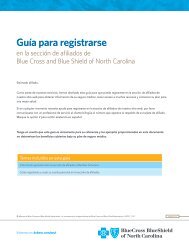Corporate Medical Policy - Blue Cross and Blue Shield of North ...
Corporate Medical Policy - Blue Cross and Blue Shield of North ...
Corporate Medical Policy - Blue Cross and Blue Shield of North ...
You also want an ePaper? Increase the reach of your titles
YUMPU automatically turns print PDFs into web optimized ePapers that Google loves.
<strong>Corporate</strong> <strong>Medical</strong> <strong>Policy</strong><br />
Extracorporeal Shock Wave Treatment for Musculoskeletal<br />
Conditions <strong>and</strong> Wound Healing<br />
File Name: extracorporeal_shock_wave_treatment_for_musculoskeletal_conditions<br />
Origination:<br />
Last CAP Review:<br />
Next CAP Review:<br />
Last Review:<br />
1/2001<br />
7/2012<br />
7/2013<br />
7/2012<br />
Description <strong>of</strong> Procedure or Service<br />
Extracorporeal shockwave treatment (ESWT), also known as orthotripsy, has been available since<br />
the early 1980s for the treatment <strong>of</strong> renal stones <strong>and</strong> has been widely investigated for the treatment<br />
<strong>of</strong> biliary stones. Shock waves create a transient pressure disturbance, which disrupts solid<br />
structures, breaking them into smaller fragments, thus allowing spontaneous passage <strong>and</strong>/or removal<br />
<strong>of</strong> stones. The mechanism by which ESWT might have an effect on musculoskeletal conditions is<br />
not well defined. Chronic musculoskeletal conditions, such as tendinitis, can be associated with a<br />
substantial degree <strong>of</strong> scarring <strong>and</strong> calcium deposition. Calcium deposits may restrict motion <strong>and</strong><br />
encroach on other structures such as nerves <strong>and</strong> blood vessels, causing pain <strong>and</strong> decreased function.<br />
One hypothesis is that disruption <strong>of</strong> these calcific deposits by shock waves may loosen adjacent<br />
structures <strong>and</strong> promote resorption <strong>of</strong> calcium, thereby decreasing pain <strong>and</strong> improving function.<br />
Other functions are also thought to be involved. Physical stimuli are known to activate endogenous<br />
pain control systems <strong>and</strong> activation by shock waves may “reset” the endogenous pain receptors.<br />
Damage to endothelial tissue from ESWT may result in increased vessel wall permeability, causing<br />
increased diffusion <strong>of</strong> cytokines, which may in turn promote healing. Microtrauma induced by<br />
ESWT may promote angiogenesis <strong>and</strong> thus aid in healing. Finally, shock waves have been shown to<br />
stimulate osteogenesis <strong>and</strong> promote callous formation in animals, which is the rationale for trials <strong>of</strong><br />
ESWT in delayed union or non-union <strong>of</strong> bone fractures.<br />
Currently, 5 ESWT devices are approved for marketing by the U.S. Food <strong>and</strong> Drug Administration<br />
(FDA). The OssaTron® device (HealthTronics, Marietta, GA), an electrohydraulic delivery system<br />
was approved by the FDA on July 20, 2000, for patients with chronic proximal plantar fasciitis—<br />
i.e., pain persisting more than 6 months <strong>and</strong> not responding to conservative management. It is also<br />
FDA approved for treatment <strong>of</strong> lateral epicondylitis (tennis elbow). The Epos Ultra (Dornier,<br />
Germering, Germany), an electromagnetic delivery system, was approved by the FDA on January<br />
15, 2002, for plantar fasciitis. The SONOCUR® Basic (Seimans, Erlangen, Germany) also uses an<br />
electromagnetic delivery system <strong>and</strong> was approved by the FDA for use in chronic lateral<br />
epicondylitis (symptoms unresponsive to conservative therapy for more than 6 months) on July 19,<br />
2002. In 2005, the Orthospec Orthopedic ESWT (Medispec Ltd, Germantown, MD), an<br />
electrohydraulic spark-gap device, <strong>and</strong> the Orbasone Pain Relief System (Orthometrix, White<br />
Plains, NY), a high-energy sonic wave system, received approval for treatment <strong>of</strong> chronic proximal<br />
plantar fasciitis in patients 18 years <strong>of</strong> age or older.<br />
Both high-dose <strong>and</strong> low-dose protocols have been investigated. A high-dose protocol consists <strong>of</strong> a<br />
single treatment <strong>of</strong> high energy shock waves (1300mJ/mm2). This painful procedure requires<br />
anesthesia. A low-dose protocol consists <strong>of</strong> multiple treatments, spaced 1 week to 1 month apart, in<br />
which a lower dose <strong>of</strong> shock waves is applied. This protocol does not require anesthesia. The FDAlabeled<br />
indication for the OssaTron® <strong>and</strong> Epos Ultra device specifically describes a high-dose<br />
An Independent Licensee <strong>of</strong> the <strong>Blue</strong> <strong>Cross</strong> <strong>and</strong> <strong>Blue</strong> <strong>Shield</strong> Association<br />
Page 1 <strong>of</strong> 9
Extracorporeal Shock Wave Treatment for Musculoskeletal<br />
Conditions <strong>and</strong> Wound Healing<br />
protocol, while the labeled indication for the SONOCUR® device describes a low-dose protocol.<br />
Another type <strong>of</strong> ESWT, radial ESWT (rESWT) received pre-market approval (PMA) in May 2007.<br />
The FDA-approved device is the Doloclast (spelled Dolorclast in the PMA summary) from EMS<br />
Electro <strong>Medical</strong> Systems, Nyon, Switzerl<strong>and</strong>. Radial ESWT is generated ballistically by<br />
accelerating a bullet to hit an applicator, which transforms the kinetic energy into radially<br />
exp<strong>and</strong>ing shock waves. Other types <strong>of</strong> ESWT produce focused shock waves that show deeper<br />
tissue penetration with significantly higher energies concentrated to a small focus. Radial ESWT is<br />
described as an alternative to focused ESWT <strong>and</strong> is said to address larger treatment areas, thus<br />
providing potential advantages in superficial applications like tendinopathies.<br />
Sanuwave Health, Inc. (Alpharetta, GA), has developed a device using shock wave therapy to treat<br />
diabetic foot ulcers. The dermaPACE® system was recently evaluated in a company-sponsored<br />
double-blinded, r<strong>and</strong>omized Phase III, Investigational Device Exemption (IDE) clinical trial.<br />
DermaPACE® was compared with Sham-control (non-active treatment), combined with current<br />
st<strong>and</strong>ard <strong>of</strong> care for the treatment <strong>of</strong> diabetic foot ulcers. (NCT00536744) At this time,<br />
dermaPACE® has not received FDA approval.<br />
Plantar Fasciitis<br />
Plantar fasciitis is a very common ailment characterized by deep pain in the plantar aspect <strong>of</strong> the<br />
heel, particularly on arising from bed. While the pain may subside with activity, in some patients<br />
the pain may persist, interrupting activities <strong>of</strong> daily living. On physical examination, firm pressure<br />
will elicit a tender spot over the medial tubercle <strong>of</strong> the calcaneus. The exact etiology <strong>of</strong> plantar<br />
fasciitis is unclear, although repetitive injury is suspected. Heel spurs are a common associated<br />
finding, although it has never been proven that heel spurs cause the pain. It should be noted that<br />
asymptomatic heel spurs can be found in up to 10% <strong>of</strong> the population.<br />
Conservative therapy <strong>of</strong> plantar fasciitis is successful in the vast majority <strong>of</strong> cases. Rest or<br />
minimization <strong>of</strong> running or jumping is the cornerstone <strong>of</strong> therapy. Heel cups are sometimes helpful<br />
in alleviating symptoms, presumably by padding the heel <strong>and</strong> absorbing the impact <strong>of</strong> walking.<br />
Nonsteroidal anti-inflammatory drugs are also helpful in acute cases. If these measures are<br />
ineffective, a local injection <strong>of</strong> steroids may be effective. Improvement is frustratingly slow <strong>and</strong><br />
gradual, taking up to a year in some cases.<br />
Tendinitis <strong>of</strong> the Elbow (Lateral Epicondylitis)<br />
Lateral epicondylitis is the most common form <strong>of</strong> tendinitis <strong>of</strong> the elbow <strong>and</strong> results in lateral elbow<br />
pain <strong>and</strong> functional limitations. The disorder is caused by overuse or injury <strong>of</strong> the tendons that<br />
attach the arm muscles to the elbow, such as commonly occurs from playing tennis (“tennis<br />
elbow”). However, only a minority <strong>of</strong> cases is caused by playing tennis, the majority occur from<br />
other activities that involve repetitive extension <strong>of</strong> the wrist. Overuse <strong>of</strong> the extensor muscles leads<br />
to microtears at their insertion point, which incites an inflammatory response. Repetitive cycles <strong>of</strong><br />
injury <strong>and</strong> inflammation lead to tendinosis, degeneration <strong>of</strong> the tendon structures, <strong>and</strong> disorganized<br />
healing.<br />
The diagnosis <strong>of</strong> lateral epicondylitis is made by characteristic pain <strong>and</strong> tenderness at the lateral<br />
aspect <strong>of</strong> the elbow, in conjunction with typical activities or injury that accompany this condition.<br />
Radiologic imaging is not necessary for diagnosis, but may be useful in ruling out other causes <strong>of</strong><br />
lateral elbow pain, such as fracture, dislocation, degenerative joint disease, <strong>and</strong> other bony or s<strong>of</strong>t<br />
tissue pathologies. Imaging is usually normal in lateral epicondylitis, although occasionally calcium<br />
deposition can be seen.<br />
An Independent Licensee <strong>of</strong> the <strong>Blue</strong> <strong>Cross</strong> <strong>and</strong> <strong>Blue</strong> <strong>Shield</strong> Association<br />
Page 2 <strong>of</strong> 9
Extracorporeal Shock Wave Treatment for Musculoskeletal<br />
Conditions <strong>and</strong> Wound Healing<br />
<strong>Policy</strong><br />
Conservative treatment consists <strong>of</strong> rest, activity modification, anti-inflammatory medications,<br />
<strong>and</strong>/or physical therapy. Corticosteroid injections <strong>and</strong> orthotic devices can also be tried as adjuncts<br />
to conservative measures. A number <strong>of</strong> surgical treatments are available for patients who do not<br />
respond to conservative treatment; approximately 5%–10% <strong>of</strong> patients with tendinitis <strong>of</strong> the elbow<br />
require surgery. Surgery may be performed as open or laparoscopic procedures. The general<br />
approach is to debride any degenerative or nonviable tissue <strong>and</strong> to repair tears or other structural<br />
abnormalities.<br />
***Note: This <strong>Medical</strong> <strong>Policy</strong> is complex <strong>and</strong> technical. For questions concerning the technical<br />
language <strong>and</strong>/or specific clinical indications for its use, please consult your physician.<br />
Extracorporeal shockwave treatment for musculoskeletal conditions <strong>and</strong> wound healing is<br />
considered investigational. BCBSNC does not cover investigational services.<br />
Benefits Application<br />
This medical policy relates only to the services or supplies described herein. Please refer to the Member's<br />
Benefit Booklet for availability <strong>of</strong> benefits. Member's benefits may vary according to benefit design;<br />
therefore member benefit language should be reviewed before applying the terms <strong>of</strong> this medical policy.<br />
When Extracorporeal Shock Wave Treatments are covered<br />
Not Applicable<br />
When Extracorporeal Shock Wave Treatments are not covered<br />
Extracorporeal shock wave therapy (ESWT), using either a high- or low-dose protocol or radial<br />
ESWT, is considered investigational, as a treatment <strong>of</strong> the following clinical conditions, including<br />
but not limited to:<br />
• plantar fasciitis;<br />
• tendinopathies: including tendinitis <strong>of</strong> the shoulder, <strong>and</strong> tendinitis <strong>of</strong> the elbow<br />
(epicondylitis, tennis elbow);<br />
• stress fractures;<br />
• delayed union <strong>and</strong> non-union fractures;<br />
• avascular necrosis <strong>of</strong> the femoral head;<br />
• wound healing;<br />
• spasticity<br />
<strong>Policy</strong> Guidelines<br />
Extracorporeal shock wave therapy (ESWT) has been investigated for use in a variety <strong>of</strong> musculoskeletal<br />
conditions. Differences in treatment parameters among studies, including energy dosage, method <strong>of</strong><br />
An Independent Licensee <strong>of</strong> the <strong>Blue</strong> <strong>Cross</strong> <strong>and</strong> <strong>Blue</strong> <strong>Shield</strong> Association<br />
Page 3 <strong>of</strong> 9
Extracorporeal Shock Wave Treatment for Musculoskeletal<br />
Conditions <strong>and</strong> Wound Healing<br />
generating <strong>and</strong> directing shock waves, <strong>and</strong> use or absence <strong>of</strong> anesthesia, limit generalizations from results<br />
<strong>of</strong> multiple studies. The precise mechanism <strong>of</strong> action <strong>of</strong> ESWT <strong>and</strong> the impact <strong>of</strong> anesthesia on outcomes<br />
continue to be matters <strong>of</strong> discussion.<br />
Data as to the effectiveness (impact on net health outcome) <strong>of</strong> ESWT in the treatment <strong>of</strong> musculoskeletal<br />
conditions remains inconclusive, including in the FDA-approved indications for plantar fasciitis <strong>and</strong><br />
lateral epicondylitis. Therefore, the benefits <strong>of</strong> this technology in the treatment <strong>of</strong> musculoskeletal<br />
conditions, including plantar fasciitis, lateral epicondylitis, patellar tendonitis, tendonitis <strong>of</strong> the shoulder,<br />
fracture nonunion, or osteonecrosis <strong>of</strong> the femoral head, remain unknown.<br />
There is inconclusive medical <strong>and</strong> scientific evidence in peer-reviewed medical literature that<br />
extracorporeal shock wave therapy for diabetic foot ulcers has a beneficial effect on health outcomes.<br />
Efficacy <strong>and</strong> safety <strong>of</strong> radial ESWT in the treatment <strong>of</strong> spasticity in patients with cerebral palsy has<br />
been examined in a small RCT from Europe in 2011. Additional study with a larger number <strong>of</strong><br />
subjects is needed to permit conclusions regarding the efficacy <strong>of</strong> this technology on spasticity.<br />
Delayed Union:<br />
Delayed union is defined as a decelerating healing process as determined by serial x-rays, together<br />
with a lack <strong>of</strong> clinical <strong>and</strong> radiologic evidence <strong>of</strong> union, bony continuity or bone reaction at the<br />
fracture site.<br />
Nonunions:<br />
The FDA labeling simply suggests that nonunion is considered established when the fracture site<br />
shows no visibly progressive signs <strong>of</strong> healing, without giving any guidance regarding the time<br />
frame <strong>of</strong> observation. However, it is suggested that a reasonable time period for lack <strong>of</strong> visible signs<br />
<strong>of</strong> healing is 3 months. The following patient selection criteria are suggested, consistent with those<br />
proposed for electrical stimulation as a treatment <strong>of</strong> nonunions:<br />
• At least 3 months have passed since the date <strong>of</strong> the fracture, AND<br />
• Serial radiographs have confirmed that no progressive signs <strong>of</strong> healing have occurred, AND<br />
• The fracture gap is 1cm or less, AND<br />
• The patient can be adequately immobilized <strong>and</strong> is <strong>of</strong> an age when he/she is likely to comply<br />
with non-weight bearing.<br />
Billing/Coding/Physician Documentation Information<br />
This policy may apply to the following codes. Inclusion <strong>of</strong> a code in this section does not guarantee that it<br />
will be reimbursed. For further information on reimbursement guidelines, please see Administrative<br />
Policies on the <strong>Blue</strong> <strong>Cross</strong> <strong>Blue</strong> <strong>Shield</strong> <strong>of</strong> <strong>North</strong> Carolina web site at www.bcbsnc.com. They are listed in<br />
the Category Search on the <strong>Medical</strong> <strong>Policy</strong> search page.<br />
Applicable codes: 0019T, 0101T, 0102T, 0299T, 0300T, 28890<br />
BCBSNC may request medical records for determination <strong>of</strong> medical necessity. When medical records are<br />
requested, letters <strong>of</strong> support <strong>and</strong>/or explanation are <strong>of</strong>ten useful, but are not sufficient documentation unless all<br />
specific information needed to make a medical necessity determination is included.<br />
Scientific Background <strong>and</strong> Reference Sources<br />
An Independent Licensee <strong>of</strong> the <strong>Blue</strong> <strong>Cross</strong> <strong>and</strong> <strong>Blue</strong> <strong>Shield</strong> Association<br />
Page 4 <strong>of</strong> 9
Extracorporeal Shock Wave Treatment for Musculoskeletal<br />
Conditions <strong>and</strong> Wound Healing<br />
Consultant Review - 01/2001<br />
Specialty Matched Consultant Advisory Panel - 8/2001<br />
BCBSA TEC Bulletin - 12/28/2001<br />
Ogden JA, Alvarez R, Levitt R et al. Shock wave therapy for chronic proximal plantar fasciitis. Clin<br />
Orthop Rel Res 2001;387:47-59.<br />
Chen HS, Liang-Mei C, Huang TW. Treatment <strong>of</strong> painful heel syndrome with shock waves. Clin<br />
Orthop Rel Res 2001;387:41-46.<br />
Rompe JD, Hopf C, Nafe B, Burger R. Low energy extracorporeal shock wave therapy for painful<br />
heel: a prospective controlled single-blind study. Arch Orthop Trauma Surg 1996;115:75-79.<br />
Rompe JD, Kullmer K, Riehle HM; Herbsth<strong>of</strong>er B, et al. Effectiveness <strong>of</strong> low-energy extracorporeal<br />
shock waves for chronic plantar fasciitis. Foot <strong>and</strong> Ankle Surgery 1996;2:215-221.<br />
BCBSA <strong>Medical</strong> <strong>Policy</strong> Reference Manual, 2/15/2002; 2.01.40<br />
BCBSA TEC Evaluation, Volume 16, No. 20, April 2002<br />
Specialty Matched Consultant Advisory Panel - 5/2003<br />
BCBSA TEC Assessment, Volume 18, No. 5, August 2003<br />
BCBSA <strong>Medical</strong> <strong>Policy</strong> Reference Manual [Electronic Version]. 2.01.40, 11/9/04<br />
BCBSA TEC Assessment, Volume 19, No. 16, February 2005<br />
BCBSA TEC Assessment, Volume 19, No. 18, March 2005<br />
Institute for Clinical Systems Improvement (ICSI). Technology Assessment Reports #86.<br />
Extracorporeal shock wave therapy for plantar fasciitis (November 2004). Retrieved 3/1/07 from<br />
http://www.icsi.org/technology_assessment_reports_-<br />
_active/ta_extracorporeal_shock_wave_therapy_for_plantar_fasciitis.html<br />
California Technology Assessment Forum (CTAF)--Extracorporeal Shock Wave Therapy (ESWT)<br />
for Musculoskeletal Disorders (June 9, 2004). Retrieved 3/2/07 from<br />
http://www.ctaf.org/content/general/detail/544<br />
California Technology Assessment Forum (CTAF)--Extracorporeal Shock Wave Therapy (ESWT)<br />
for the Treatment <strong>of</strong> Lateral Epicondylitis (October 20, 2004). Retrieved 3/2/07 from<br />
http://www.ctaf.org/content/general/detail/545<br />
BCBSA <strong>Medical</strong> <strong>Policy</strong> Reference Manual [Electronic Version]. 2.01.40, 12/14/05<br />
National Institute for Clinical Excellence (NICE). Extracorporeal shockwave therapy for refractory<br />
tendinopathies (plantar fasciitis <strong>and</strong> tennis elbow). Interventional Procedure Guidance 139. London,<br />
UK: NICE; November 2005. Retrieved 3/1/07 from<br />
http://www.nice.org.uk/pdf/ip/IPG139guidance.pdf<br />
Canadian Agency for Drugs <strong>and</strong> Technologies in Health (CADTH). Extracorporeal shockwave<br />
treatment for chronic plantar fasciitis (heel pain). (January 2007). Retreived 2/15/07 from<br />
An Independent Licensee <strong>of</strong> the <strong>Blue</strong> <strong>Cross</strong> <strong>and</strong> <strong>Blue</strong> <strong>Shield</strong> Association<br />
Page 5 <strong>of</strong> 9
Extracorporeal Shock Wave Treatment for Musculoskeletal<br />
Conditions <strong>and</strong> Wound Healing<br />
http://www.cadth.ca/media/pdf/E0009_chronic-plantar-fasciitis-part1_cetap_e.pdf<br />
Canadian Agency for Drugs <strong>and</strong> Technologies in Health (CADTH). Extracorporeal shockwave<br />
treatment for chronic lateral epicondylitis (tennis elbow). (January 2007). Retreived 2/15/07 from<br />
http://www.cadth.ca/media/pdf/E0012_chronic-lateral-epicondylitis-part2_cetap_e.pdf<br />
Canadian Agency for Drugs <strong>and</strong> Technologies in Health (CADTH). Extracorporeal shockwave<br />
treatment for chronic rotator cuff tendonitis (shoulder pain). (January 2007). Retreived 2/15/07<br />
from http://www.cadth.ca/media/pdf/E0013_chronic-shoulder-pain-part3_cetap_e.pdf<br />
BCBSA <strong>Medical</strong> <strong>Policy</strong> Reference Manual [Electronic Version]. 2.01.40, 12/11/08<br />
National Institute for Clinical Excellence (NICE). Guidance on extracorporeal shockwave therapy<br />
for refractory plantar fasciitis. Interventional Procedure Guidance 311. London, UK: NICE; August<br />
2009. Retrieved on May 18, 2010 from<br />
http://www.nice.org.uk/nicemedia/live/11187/45188/45188.pdf<br />
National Institute for Clinical Excellence (NICE). Guidance on extracorporeal shockwave therapy<br />
for refractory Achilles tendinopathy. Interventional Procedure Guidance 312. London, UK: NICE;<br />
August 2009. Retrieved on May 18, 2010 from<br />
http://www.nice.org.uk/nicemedia/pdf/IPG312Guidance.pdf<br />
National Institute for Clinical Excellence (NICE). Guidance on extracorporeal shockwave therapy<br />
for refractory tennis elbow. Interventional Procedure Guidance 313. London, UK: NICE; August<br />
2009. Retrieved on May 18, 2010 from http://www.nice.org.uk/nicemedia/pdf/IPG313Guidance.pdf<br />
California Technology Assessment Forum (CTAF). Extracorporeal shockwave therapy (ESWT) for<br />
plantar fasciitis not responding to conservative therapy. October 28, 2009. Retrieved on May 18,<br />
2010 from http://www.ctaf.org/sites/default/files/assessments/1074_file_ESWT_2009_W_final.pdf<br />
Greve JM, Grecco MV, Santos-Silva PR. Comparison <strong>of</strong> radial shockwaves <strong>and</strong> conventional<br />
physiotherapy for treating plantar fasciitis. Clinics. 2009 February; 64(2): 97–103. Retrieved on<br />
June 28, 2010 from http://www.ncbi.nlm.nih.gov/pmc/articles/PMC2666476/?tool=pubmed<br />
BCBSA <strong>Medical</strong> <strong>Policy</strong> Reference Manual [Electronic Version]. 2.01.40, 12/10/09<br />
Specialty Matched Consultant Advisory Panel review 7/2010<br />
Ibrahim MI, Donatelli RA, Schmitz C et al. Chronic plantar fasciitis treated with two sessions <strong>of</strong><br />
radial extracorporeal shock wave therapy. Foot Ankle Int 2010; 31(5):391-7.<br />
Greve JM, Grecco MV, Santos-Silva PR. Comparison <strong>of</strong> radial shockwaves <strong>and</strong> conventional<br />
physiotherapy for treating plantar fasciitis. Clinics (Sao Paulo) 2009; 64(2):97-103.<br />
Thomas JL, Christensen JC, Kravitz SR et al. The diagnosis <strong>and</strong> treatment <strong>of</strong> heel pain: a clinical<br />
practice guideline-revision 2010. J Foot Ankle Surg 2010; 49(3 Suppl):S1-19.<br />
Barnes M. Letter to the editor. "Low-energy extracorporeal shock wave therapy as a treatment for<br />
medial tibial stress syndrome". Am J Sports Med 2010; 38(11):NP1-2.<br />
Chen JM, Hsu SL, Wong T et al. Functional outcomes <strong>of</strong> bilateral hip necrosis: total hip<br />
arthroplasty versus extracorporeal shockwave. Arch Orthop Trauma Surg 2009; 129(6):837-41.<br />
Cacchio A, Giordano L, Colafarina O et al. Extracorporeal shock-wave therapy compared with<br />
An Independent Licensee <strong>of</strong> the <strong>Blue</strong> <strong>Cross</strong> <strong>and</strong> <strong>Blue</strong> <strong>Shield</strong> Association<br />
Page 6 <strong>of</strong> 9
Extracorporeal Shock Wave Treatment for Musculoskeletal<br />
Conditions <strong>and</strong> Wound Healing<br />
surgery for hypertrophic long-bone nonunions. J Bone Joint Surg Am 2009; 91(11):2589-97.<br />
Zelle BA, Gollwitzer H, Zlowodzki M et al. Extracorporeal shock wave therapy: current evidence. J<br />
Orthop Trauma 2010; 24(Suppl 1):S66-70.<br />
Wang CJ, Liu HC, Fu TH. The effects <strong>of</strong> extracorporeal shockwave on acute high-energy long bone<br />
fractures <strong>of</strong> the lower extremity. Arch Orthop Trauma Surg 2007; 127(2):137-42.<br />
BCBSA <strong>Medical</strong> <strong>Policy</strong> Reference Manual [Electronic Version]. 2.01.40, 2/10/11<br />
Specialty Matched Consultant Advisory Panel review 7/2011<br />
Food <strong>and</strong> Drug Administration (FDA) Clinical Trial #NCT00536744. Effectiveness <strong>of</strong><br />
dermaPACE Device <strong>and</strong> St<strong>and</strong>ard Treatment Compared to St<strong>and</strong>ard Treatment Alone for Diabetic<br />
Foot Ulcers. Retrieved on December 5, 2011 from http://clinicaltrials.gov/ct2/show/NCT00536744<br />
<strong>Medical</strong> Director review 12/2011<br />
Vidal X, Morral A, Costa L et al. Radial extracorporeal shock wave therapy (rESWT) in the<br />
treatment <strong>of</strong> spasticity in cerebral palsy: a r<strong>and</strong>omized, placebo-controlled clinical trial.<br />
NeuroRehabilitation 2011; 29(4):413-9.<br />
BCBSA <strong>Medical</strong> <strong>Policy</strong> Reference Manual [Electronic Version]. 2.01.40, 2/9/12<br />
National Institute for Health <strong>and</strong> Clinical Excellence (NICE). Extracorporeal shockwave therapy for<br />
refractory greater trochanteric pain syndrome. 2011. Retrieved on April 2, 2012 from:<br />
http://www.nice.org.uk/nicemedia/live/12975/52604/52604.pdf<br />
Specialty Matched Consultant Advisory Panel review 7/2012<br />
BCBSA <strong>Medical</strong> <strong>Policy</strong> Reference Manual [Electronic Version]. 2.01.40, 2/9/12<br />
Jeon JH, Jung YJ, Lee JY et al. The effect <strong>of</strong> extracorporeal shock wave therapy on my<strong>of</strong>ascial pain<br />
syndrome. Ann Rehabil Med 2012; 36(5):665-74. Retrieved from<br />
http://www.ncbi.nlm.nih.gov/pmc/articles/PMC3503942/<br />
BCBSA <strong>Medical</strong> <strong>Policy</strong> Reference Manual [Electronic Version]. 2.01.40, 2/14/13<br />
<strong>Policy</strong> Implementation/Update Information<br />
01/01 New policy issued.<br />
07/01 <strong>Policy</strong> re-titled. Name changed from Extracorporeal Shock Wave Lithotripsy for<br />
Orthopedic Problems to Lithotripsy, Extracorporeal, for Orthopedic Problems.<br />
8/01 Specialty Matched Consultant Advisory Panel. No changes.<br />
1/02 Changed policy to cover Extracorporeal shock wave lithotripsy for plantar fasciitis<br />
according to criteria stated in policy. Remains investigational for all other musculoskeletal<br />
problems.<br />
5/02 Revised to include "chronic proximal" plantar fasciitis for clarification. Typos corrected.<br />
Format changes.<br />
An Independent Licensee <strong>of</strong> the <strong>Blue</strong> <strong>Cross</strong> <strong>and</strong> <strong>Blue</strong> <strong>Shield</strong> Association<br />
Page 7 <strong>of</strong> 9
Extracorporeal Shock Wave Treatment for Musculoskeletal<br />
Conditions <strong>and</strong> Wound Healing<br />
9/02 <strong>Medical</strong> director review. Revised section under when it is covered to clarify criteria.<br />
Added numbers 4. <strong>and</strong> 5. a. - c. Typos corrected.<br />
11/02 <strong>Policy</strong> revised under when it is covered <strong>and</strong> when it is not covered to include criteria for<br />
chronic lateral epicondylitis. Criteria numbers 4. <strong>and</strong> 5. a. - c. were moved under the <strong>Policy</strong><br />
Guidelines section. Format changes. System coding changes.<br />
2/03 <strong>Policy</strong> revised under the Description section to include low <strong>and</strong> high energy shock waves.<br />
<strong>Policy</strong> Guidelines revised to include low <strong>and</strong> high energy shock wave therapy. Codes G0279 <strong>and</strong><br />
G0280 added to Billing/Coding section.<br />
2/03 Terms added to the <strong>Medical</strong> Term Definitions.<br />
5/03 Specialty Matched Consultant Advisory Panel review. No criteria changes.<br />
4/04 Benefits Application <strong>and</strong> Billing/Coding sections updated for consistency.<br />
6/2/2005 Specialty Matched Consultant Advisory Panel review on 5/23/2005. No changes<br />
made to policy statement. Code descriptions removed. SUR6323 added as key word. References<br />
added.<br />
7/07/2005 Codes 0101T <strong>and</strong> 0102T added to Billing/Coding section.<br />
8/18/2005 Coverage criteria section <strong>of</strong> the policy revised as following: 1. (no change) 2.<br />
Changed " There has been a lack <strong>of</strong> response over at least 6 weeks..." to "There has been a<br />
documented lack <strong>of</strong> response over at least 6 weeks..."; "a. rest" changed to "a. rest (defined as use<br />
<strong>of</strong> a cast boot or cessation <strong>of</strong> painful activities for plantar fasciitis); "b. physical therapy" changed<br />
to "b. a formal physical therapy program, which can include either compliance with a home exercise<br />
program taught in the physician’s <strong>of</strong>fice (in which case the specifics <strong>of</strong> the program as well as<br />
specific references to compliance must be documented in the record; merely referring to<br />
"stretching" is not sufficient) OR supervised physical therapy in a physical therapy facility<br />
documented by appropriate records"; "c. anti-inflammatory medication" changed to "c. antiinflammatory<br />
medication (name <strong>of</strong> medication, dose <strong>and</strong> frequency must be specified)"; d. (no<br />
change) e. (no change) 3. (no change). Additional notation made in this section, "Please note:<br />
information supplied in cover letters does not replace the need to provide copies <strong>of</strong> <strong>of</strong>fice records to<br />
document compliance with the criteria above." Notification given 8/18/2005. <strong>Policy</strong> effective date<br />
10/20/2005.<br />
1/05/06 CPT Codes G0279, G0280, 0020Tdeleted <strong>and</strong> CPT Code 28890 added to Billing/Coding<br />
section.<br />
7/2/07 Item 1 in the When Lithotripsy is Covered section revised to read: The history in the record<br />
must be <strong>of</strong> sufficient detail to establish chronicity <strong>of</strong> symptoms for at least 6 months. (This consists<br />
<strong>of</strong> persistent symptoms over a 6 month period <strong>of</strong> time with no more than 4 weeks <strong>of</strong> symptom-free<br />
time after prior interventions.) References updated. Specialty Matched Consultant Advisory Panel<br />
review 5/18/07. (adn)<br />
7/6/09 Specialty Matched Consultant Advisory Panel review 5/21/09. No change to policy<br />
statement.(adn)<br />
For <strong>Policy</strong> Renamed: Extracorporeal Shock Wave Treatment for Musculoskeletal Conditions<br />
9/28/09 <strong>Policy</strong> name changed from Lithotripsy, Extracorporeal, for Orthopedic Problems to<br />
Extracorporeal Shock Wave Treatment for Musculoskeletal Conditions. Description section<br />
An Independent Licensee <strong>of</strong> the <strong>Blue</strong> <strong>Cross</strong> <strong>and</strong> <strong>Blue</strong> <strong>Shield</strong> Association<br />
Page 8 <strong>of</strong> 9
Extracorporeal Shock Wave Treatment for Musculoskeletal<br />
Conditions <strong>and</strong> Wound Healing<br />
extensively revised. <strong>Policy</strong> statement changed to read: BCBSNC will not provide coverage for<br />
extracorporeal shockwave treatment for musculoskeletal conditions. It is considered investigational<br />
<strong>and</strong> BCBSNC does not cover investigational services. Information in the When Covered section was<br />
deleted <strong>and</strong> replaced with the statement: "not applicable." Information in the When Not Covered<br />
section was deleted <strong>and</strong> replaced with the following: "Extracorporeal shock wave therapy (ESWT),<br />
using either a high- or lo-dose protocol or radial ESWT, is considered investigational, as a<br />
treatment <strong>of</strong> musculoskeletal conditions, including but limited to: plantar fasciitis; tendinopathies,<br />
including tendinitis <strong>of</strong> the shoulder <strong>and</strong> tendinitis <strong>of</strong> the elbow (epicondylitis, tennis elbow); stress<br />
fractures; delayed union <strong>and</strong> non-union fractures; avascular necrosis <strong>of</strong> the femoral head."<br />
Notification given 9/28/09. Effective date 1/01/10. (adn)<br />
08/17/10 Specialty Matched Consultant Advisory Panel review 7/2010. <strong>Medical</strong> <strong>Policy</strong> number<br />
removed. References updated. (mco)<br />
4/26/11 Description section updated. References updated. <strong>Policy</strong> Guidelines updated. No change to<br />
policy statement. (mco)<br />
8/16/11 Specialty Matched Consultant Advisory Panel review 7/2011. No changes to policy<br />
statements. (mco)<br />
For <strong>Policy</strong> Re-titled: Extracorporeal Shock Wave Treatment for Musculoskeletal Conditions<br />
<strong>and</strong> Wound Healing<br />
12/30/11 <strong>Policy</strong> re-titled to “Extracorporeal Shock Wave Treatment for Musculoskeletal Conditions<br />
<strong>and</strong> Wound Healing.” “Description” section updated to include information on dermaPACE®, new<br />
ESWT for treatment <strong>of</strong> diabetic foot ulcers. “When not Covered” section updated to include wound<br />
healing as an investigational clinical condition. 0299T <strong>and</strong> 0300T added to “Billing/Coding”<br />
section. New codes to be effective 1/1/2012. “<strong>Policy</strong> Guidelines” section updated. References<br />
update. <strong>Medical</strong> Director review 12/2011. (mco)<br />
5/1/12 “When not Covered” section updated to include treatment <strong>of</strong> spasticity. <strong>Policy</strong> Guidelines<br />
updated. References updated. <strong>Medical</strong> Director review 4/2012. (mco)<br />
8/7/12 Specialty Matched Consultant Advisory Panel review 7/2012. No changes to <strong>Policy</strong><br />
Statement. (mco)<br />
4/1/13 References updated. <strong>Policy</strong> Guidelines updated. No changes to <strong>Policy</strong> Statement. (mco)<br />
<strong>Medical</strong> policy is not an authorization, certification, explanation <strong>of</strong> benefits or a contract. Benefits <strong>and</strong> eligibility are determined<br />
before medical guidelines <strong>and</strong> payment guidelines are applied. Benefits are determined by the group contract <strong>and</strong> subscriber<br />
certificate that is in effect at the time services are rendered. This document is solely provided for informational purposes only <strong>and</strong><br />
is based on research <strong>of</strong> current medical literature <strong>and</strong> review <strong>of</strong> common medical practices in the treatment <strong>and</strong> diagnosis <strong>of</strong><br />
disease. <strong>Medical</strong> practices <strong>and</strong> knowledge are constantly changing <strong>and</strong> BCBSNC reserves the right to review <strong>and</strong> revise its<br />
medical policies periodically.<br />
An Independent Licensee <strong>of</strong> the <strong>Blue</strong> <strong>Cross</strong> <strong>and</strong> <strong>Blue</strong> <strong>Shield</strong> Association<br />
Page 9 <strong>of</strong> 9


